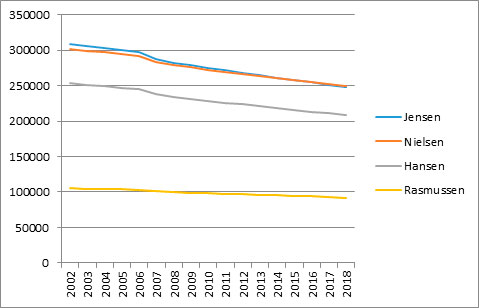Rasmussen – an unusually ordinary surname
When Denmark's participant went on stage at the 2018 Eurovision Song Contest in Lisbon it was under the stage-name Rasmussen. Although this is the artist's actual surname, it is surprising that such a common name should be selected as the stage-name for a singer in a period when the common Danish surnames are often exchanged for less common ones.

Rasmussen has been one of the most common surnames since all Danes in the 19th century were directed to adopt fixed surnames. However, there has been a drop in the use of such names in later years, as well as other very common sen-surnames.
The sen-surnames are formed on the basis of the masculine Christian names which were most frequently used at the period when surnames were made hereditary for everybody. In a study of the most common Christian names in Denmark in the Census from 1801/03 Rasmus was the 7th most frequently occurring masculine name.
The Rasmus banana
At that period the name had a peculiar spread in a banana-shaped area stretching from the Djursland peninsula in the north across eastern Jutland to Fyn and the Lolland and Falster islands in the south-east.
The reason for the peculiar spread of Rasmus is unknown, but it might have to do with church organisation, since the banana-shaped area roughly corresponds to the bishoprics of Aarhus and Odense. One could imagine that there has been a particular focus on St. Erasmus in these areas, yielding a wider use of the name Rasmus – which is the Danish form of Erasmus.

The frequent Danish sen-surnames
Originally Rasmussen is a patronym meaning 'son of Rasmus'. Until the 19th century normally only the patronym Rasmussen (or Rasmusdatter 'daughter of Ramus') was used as surname by children having a father called Rasmus. But in 1828 all Danish inhabitants were obliged to christen their children with a supplementary surname – which was to be recorded in the church registers where only first names had been recorded until then. In principle parents could choose any surname, but most chose to record a patronym, and a lot of them were identical.
The reason for the new surname legislation was probably the increasing migration of the rural population to larger towns, which in itself increased the difficulty of individual identification of the high number of people bearing identical first names. But the problem was not properly solved since many now bore identical surnames either way.
The retreat of the sen-surnames
The many identical surnames became a problem for the authorities, and in the beginning of the 20th century the population was urged by the government to adopt new surnames. There were several Danes who did do so, but still in 1970 about 70% of the Danish population bore a sen-surname.
In later years, however, the decrease in the number of sen-surnames has gone much faster than ever: fastest for the name Jensen, which until 2016 was the most common surname in Denmark – only to be replaced by another sen-surname, Nielsen that has lost its popularity at a slightly slower rate.
Rasmussen is not falling as quickly in popularity but all the common sen-sunames are decreasing in number in present years, probably because many people want to have names that are more unusual and therefore more distinctive for the individual family.
The number of bearers of Rasmussen has fallen from 105,515 in 2002 to 91,963 in 2018. This is a fall in the number of name-bearers of 12.8% since 2002 and this is rather considerable. But if we look at the more common names, the falls are even greater: Nielsen 17.5%, Jensen 19.9% and Hansen 17.9%, This is also shown by the curve for Rasmussen in the figure below falling less steeply than those for the three most common surnames.

In spite of the fact that there is a widespread desire to have something other than a sen-name as a surname, we saw at the European Song Contest in Lisbon – as mentioned above – a Danish participant who employed Rasmussen as his stage-name. At the national qualification round, which was held in February the same year, one of the contestants was even a group calling itself Carlsen.
Are sen-names perhaps beginning to become popular again? Or is the special Danish characteristics of the frequent sen-surnames maybe an advantage when performing abroad? Although Rasmussen is quite common in Denmark and has been borne by 3 Danish prime-ministers since the 1990's, it is still rather unusual outside of the country.
Birgit Eggert
Contact
Birgit Eggert is associate professor at the Name Research Archive, Department of Nordic Studies and Linguistics
beggert@hum.ku.dk
Phone: +45 3532 8563
